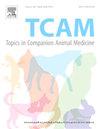Retrospective study on antimicrobial resistance in bacteria isolated from clinical infections in Dogs at a Brazilian Veterinary Teaching hospital
IF 1.3
3区 农林科学
Q2 VETERINARY SCIENCES
引用次数: 0
Abstract
Antimicrobial resistance is an increasing concern impacting both human and animal health. This cross-sectional and retrospective study analyzed 1,108 clinical samples from dogs treated at a veterinary teaching hospital in Espírito Santo, Brazil, between 2019 and 2023. Microbiological cultures were performed on the samples, and antimicrobial susceptibility profiles were determined using the disk diffusion method. The objective was to identify the main pathogens, assess bacterial resistance patterns, and detect the presence of multidrug-resistant (MDR) bacteria. Of the samples analyzed, 793 (71.57%) showed bacterial growth, yielding a total of 1,140 isolates, as 268 samples were polymicrobial infections (involving more than one bacterial species). The most affected systems were the oto-dermal system (68.60% [782/1,140]), followed by the urinary system (23.25% [265/1,140]). Among the isolates, Gram-positive bacteria predominated (54.60% [623/1,140]), with Staphylococcus spp. being the most frequent (41.05% [468/1,140]). Among Gram-negative bacteria, the most prevalent species were Pseudomonas aeruginosa (11.75% [134/1,140]) and Escherichia coli (11.49% [131/1,140]). The highest resistance were associated with sulfonamides/trimethoprim, azithromycin, and ampicillin. Multidrug resistance was identified in 15.01% (136/906) of the isolates, mainly among Enterobacteriaceae (12.80% [116/906]). The findings suggest that bacterial resistance is associated with the intensive use of antimicrobials commonly prescribed by the clinical community in the study area and varies depending on the microorganism and the infected system. In conclusion, continuous surveillance is essential to guide the rational use of antimicrobials, thereby reducing the impact of bacterial resistance. Additionally, analyzing the resistance profiles of clinical isolates is crucial for the effective treatment of dogs requiring antibiotic therapy.
巴西一家兽医教学医院犬类临床感染分离细菌耐药性回顾性研究
抗菌素耐药性日益受到关注,影响着人类和动物的健康。这项横断面和回顾性研究分析了2019年至2023年期间在巴西圣托Espírito兽医教学医院接受治疗的1108只狗的临床样本。对样品进行微生物培养,采用纸片扩散法测定药敏谱。目的是确定主要病原体,评估细菌耐药模式,并检测多重耐药细菌的存在。在分析的样品中,793份(71.57%)显示细菌生长,共分离出1,140株,其中268份为多微生物感染(涉及不止一种细菌)。受影响最大的是耳皮肤系统(68.60%[782/ 1140]),其次是泌尿系统(23.25%[265/ 1140])。其中以革兰氏阳性菌为主(54.60%[623/ 1140]),以葡萄球菌最多(41.05%[468/ 1140])。革兰氏阴性菌中以铜绿假单胞菌(11.75%[134/ 1140])和大肠杆菌(11.49%[131/ 1140])最多。耐药性最高的是磺胺类药物/甲氧苄啶、阿奇霉素和氨苄西林。耐多药菌株占15.01%(136/906),主要为肠杆菌科(12.80%[116/906])。研究结果表明,细菌耐药性与研究地区临床社区常用抗菌药物的大量使用有关,并因微生物和感染系统而异。总之,持续监测对指导合理使用抗微生物药物至关重要,从而减少细菌耐药性的影响。此外,分析临床分离株的耐药概况对于需要抗生素治疗的狗的有效治疗至关重要。
本文章由计算机程序翻译,如有差异,请以英文原文为准。
求助全文
约1分钟内获得全文
求助全文
来源期刊

Topics in companion animal medicine
农林科学-兽医学
CiteScore
2.30
自引率
0.00%
发文量
60
审稿时长
88 days
期刊介绍:
Published quarterly, Topics in Companion Animal Medicine is a peer-reviewed veterinary scientific journal dedicated to providing practitioners with the most recent advances in companion animal medicine. The journal publishes high quality original clinical research focusing on important topics in companion animal medicine.
 求助内容:
求助内容: 应助结果提醒方式:
应助结果提醒方式:


